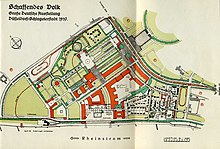Reichsausstellung Schaffendes Volk

The Reichsausstellung Schaffendes Volk 1937 in Düsseldorf was the most important, also externally most important propaganda show in Germany during National Socialism .
history
As early as the 1920s there were planning ideas for the construction of an exhibition park in the area of the "Golzheimer Heide", which stretched north of the suburb of Golzheim between the Rhine and the district of Rath . There, not far from the banks of the Rhine, the so-called “New Academy” or “New Art Academy”, a complex of artist apartments and studios of the Düsseldorf Art Academy , had been located since 1915 . The idea of an exhibition park was given a new impetus after Düsseldorf had become the capital of an NSDAP Gaus in 1930 and the Gauleiter Friedrich Karl Florian had developed ambitious ideas through a competition for a Schlageter forum up until the mid-1930s through a competition held in 1934 , Düsseldorf based on the Schlageter -Cult to make the Schlageter National Monument as well as Düsseldorf trade fair and art exhibition traditions as the center of the Gaus Düsseldorf to the center of National Socialism in West Germany. The resulting plans took a year and a half to prepare, and with them a completely new city quarter was created in Düsseldorf, which was named after Albert Leo Schlageter Schlageterstadt . In July 1936 it was announced that paths and parts of paths for public transport would be drawn in for the intended area of the exhibition park.
Over six million people flocked to the Rhine from Germany and abroad to see the "new German living", the "new German work" and the " new German art ". From the implemented concept, the park of the north park , the adjoining model settlements and a broad section of Kaiserswerther Strasse have been preserved today.
The two model settlements created were the Wilhelm Gustloff settlement, today Nordparkiedlung in Stockum , with 14 houses in the north of the exhibition site, which represented a workers' settlement and the Schaffendes Volk settlement , from 1937 Schlageterstadt , today Golzheimer settlement , in the southern part of the exhibition site with living space the high demands for executives from politics, business and art.
Participating architects (selection)
- Fritz Becker - artistic design of the open space; furthermore the construction of the confectioner's café, the round plant hall, buildings at the concert square and the water garden, the pergola at the iris garden and the pergola in the rose garden, confectionery café, dance ring
- Peter Dierichsweiler - "Hall of Honor of the Party", the Maximilian-Weyhe House , since 1960 the seat of the garden, cemetery and forest office of the city of Düsseldorf, Kaiserswerther Strasse 390
- Arnold Emundts - artistic director of the architecture office
- Wilhelm Elmpt - Railway stations of the Liliputbahn of the Rheinische Bahngesellschaft
- Emil Fahrenkamp - group of buildings at the main festival area and the Mannesmann pavilion
- Peter Grund - artistic director, overall development plan
- Robert Meyer - Head of the architectural office
- Leopold Schmalhorst
- Walter von Wecus - responsible for the "artistic design" of the "light, flag and water games"
Architects of the houses in the "Schlageter settlement" in 1937, including Wilhelm Elmpt , Peter Grund, Helmut Hentrich , Hans Junghanns , Walter Koengeter , Hans Heinz Lüttgen , Wilhelm Mohr , Ernst Petersen , Klaus Reese , Heinz Thoma .
Participating garden architects (selection)
- Wilhelm Tapp (1887–1957) - gardening director
- Hans Schiller
- Wilhelm Nerche (* 1884) - rose garden
Participating artists (selection)
- Josef Daniel Sommer
- Zoltan Székessy - "Seated child" for a well in the Schlageter settlement
- Edwin Scharff - the "horse tamers"
- Kurt Zimmermann - "Farmer" and "Farmer's wife", sculptures by the group "The Estates"
- Alexander Zschokke - "Fisherman" and "Sailor" (lost), sculptures by the group "The Estates"
- Willi Hoselmann - "Falkner", sculpture by the group "Die Ständischen"
- Alfred Zschorsch - "Winemaker", sculpture by the group "The Estates"
- Robert Ittermann - "Shepherdess", sculpture by the group "The Estates"
- Johannes Knubel - "Seated", limestone sculpture
- Arno Drescher - poster design
- Oswald Petersen - wall painting
- Kurt Otte (* 1921) - Murals in Hall 36, Mannesmann Röhrenweke
- Hans Kohlschein - two murals in Hall 12, Reich Association of Public Insurance; Wall paintings in Hall 13, Henkel
literature
- Stefanie Schäfers: From the Werkbund to the four-year plan. The exhibition Schaffendes Volk, Düsseldorf 1937. Sources and research on the history of the Lower Rhine. Edited by Düsseldorfer Geschichtsverein, Volume 4, Droste, Düsseldorf 2001. ISBN 3-7700-3045-1 - Web pages
- Wieland Koenig (foreword), Werner Alberg (adaptation): Düsseldorfer Kunstszene 1933–1945 , City of Düsseldorf. City Museum, 1987, ISBN 3926895004
Web links
- Garden Office of the State Capital Düsseldorf: Imperial Exhibition of the Creative People
- Karl Hoeffkes - Exhibition "Schaffendes Volk" in Düsseldorf '37 (M908) , historical 16 mm film (5:42 min)
- Website about the exhibition "Schaffendes Volk 1937" by Stefanie Schäfers
Individual evidence
- ↑ Stefan Starek: Architecture at the "Reich Exhibition of Creative People 1937" . In: Dieter Breuer, Gertrude Cepl-Kaufmann (Ed.): Modernism and National Socialism in the Rhineland . F. Schöningh, Münster 1997, p. 504
- ↑ Stefanie Schäfers: From the Werkbund to the four-year plan. The exhibition "Schaffendes Volk", Düsseldorf 1937 . In: Düsseldorfer Geschichtsverein (Hrsg.): Sources and research on the history of the Lower Rhine , Volume 4 (= contributions from the Research Center for Architectural History and Monument Preservation of the Bergische Universität Wuppertal University , Volume XI), Droste Verlag, Düsseldorf 2001, ISBN 3-7700- 3045-1 . See website Existing development I
- ↑ 493. Announcement, from July 15, 1936 , in the official gazette for the administrative district of Düsseldorf, year 1936, p. 199
- ^ Poster of the Reich Exhibition of the Creative People , by Arno Drescher
